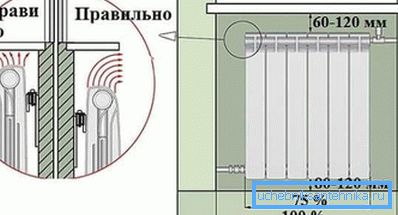Bimetallic heating radiators specifications, design
In our time, the market has a large range of radiators. In particular, steel, cast iron and aluminum products of different brands are presented. But bimetal batteries are a separate group - for sure you have heard this classification more than once.
In this article we will consider the most important technical characteristics of bimetallic radiators of heating, and also we will study all the most useful information on them. Such data will help you decide whether to buy or not to buy.

Let's start with the essence of the design.
Why radiators are called bimetallic
There is really nothing difficult to understand here - this name means that two different metals were used to manufacture the battery.
Usually, aluminum and steel are used, but there are also more expensive options - heating radiators made of copper and aluminum. Consider the classic and affordable solution - aluminum-steel sections.
Briefly, in essence, such heaters are steel pipes that are “lined” with aluminum panels. In fact, of course, everything is much more complicated - the metals are soldered together. This can be seen if you look at the section from the side, as if in a section.

Features are discussed in the table below.
| Benefits: | Disadvantages: |
|
|
What else is worth noting is the excellent resistance of the surface to mechanical stress. As a rule, such radiators are covered with a durable layer of powder paint, which is quite difficult to scratch.
What else I want to mention is the cost-effectiveness of products. The instruction for the manufacture of batteries is such that the channels through which the coolant flows are rather narrow in diameter. The water passage tubes are at least two times narrower than all other products. This saves resources on heating the fluid.

Note that it is very undesirable to frequently drain water from the system with such radiators. This is fraught with the penetration of oxygen into the structure of steel, which gradually leads to corrosion.
In principle, we’ll dwell on this and move on to the more useful part of the article.
What technical characteristics to pay attention to when choosing a radiator
First of all, I would like to note one important feature - no welding, soldering irons and other special tools will be needed. Because the sections are easily assembled with your own hands, since all you need to do is to insert the gaskets in the right places, process them with silicone and tighten the connections with a special key.

Therefore, when choosing radiator heating products - that each brand is going to differently - you should not worry. Everything is standardized.
But the characteristics, of course, may be different - let's look at such moments.
Heat dissipation and maximum operating temperature
Thermal conductivity is prescribed in watts and for standard situations the optimal indicator of this property is 170 - 200 watts. If simple, this parameter informs the user about how much heat the radiator will be able to give during the passage of hot heat carrier through it.
As for the temperature, then everything is more or less the same - most products calmly withstand water heated to 90 degrees. Above - this is almost boiling water and evaporation, respectively, more hot water in the systems does not exist in principle.
But other types of coolants may have a higher temperature - so if you do not have water in the system, then it is better to look for a product with parameters up to 130 degrees.
Thermal conductivity of thermal conductivity, but there are a couple of factors that directly affect the "supply" of warm air into the room. The first is the size of bimetallic radiators and, of course, the number of sections.
We will deal with the size and at the same time with the pressure.
Center Distance and Working Pressure

Under this distance most often means the size of the space between the upper and lower axis of the battery. The numbers here can be different: from 200 to 800 mm. It is clear that the larger the figure, the greater the height of the radiator and, accordingly, the level of its efficiency, heat transfer.
Please note that the height is high, but you need to follow certain installation rules. For example, it is necessary to withstand the distance from the floor and the lower edge of the window - this distance should be about 5-10 centimeters.

As far as pressure is concerned, usually on such batteries there is no indicator less than 32 atmospheres. This parameter is in most cases quite sufficient, since the standard pressure in autonomous systems of private houses is about 2-3 atmospheres, and in centralized systems it is 7-12.
Conclusion
We have examined what are bimetallic radiators, and what characteristics it is important to pay attention to when buying such batteries. We hope that you will use the information provided in full and in practice - that is, you will be able to choose the best option for your home. If you want to know more on this issue, then check out the video at the end of this article.